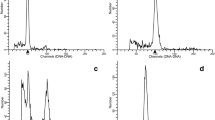Abstract
A fully fertile interspecific hybrid (Cucumis hytivus Chen and Kirkbride, 2n =4x =38) between Cucumis hystrix Chakr. (2n= 2x =24) and C. sativus L. (2n = 2x = 14) was previously produced by means of F1 (2n = 19) embryo rescue and subsequent chromosome doubling. This amphidiploid, a new synthetic species, may serveas a genetic bridge in Cucumis, and thus is a source for broadening the genetic base of C. sativus. The identification and characterization of fertile progeny possessing lower ploidy levels would facilitate bridging among Cucumis species. Putative allotriploids (2n = 26) were recovered from C. hytivus × C. sativus matings by means of embryo culture, and experiments were designed to confirm their genetic constitution, describe their morphology, and establish an efficient protocol for their micropropagation. Apical and axillary buds of these putative allotriploid plants were used as explants to establish a micropropagation system for subsequent verification and characterization of ploidy. Of the array of micropropagation media tested, then ability to be most effective for the induction of adventitious buds (desginated Stage II) was a Murashige and Skoog (MS)growth media containing 13.3μM BA + 1.1μM NAA or containing10 μm BA only. The mean number of adventitious buds per explant in the two media was 6.8 and 6.5, respectively. Shoots resulting from adventitious buds produced roots (Stage III) in relative abundance (39 of 42, 92.8%) on half-strength MS medium containing 1.0 μm IBA. The survivorship of rooted plantlets after acclimatization as assessed by relative production of leaves in plantlets (designated Stage IV) was 91.4% (148 of 162). The chromosome number in putative allotriploid plants as determined in mitotic root tip figures in all plants was 2n = 26, the number expected for allotriploids derived from such a mating. An examination of pollen viability in five samples of each plant by cytochemical staining revealed stainability to be < %.Compared to their parents, the allotriploid genotypes possess a high degree of parthenocarpy (84.8%) as measured by setting fruit in pollen-free conditions. While allotriploid fruit are black-spined and similar to the maternal parent C. hytivus, the dark green leaves typical of allotriploid plants mirrors that of the paternal C. sativus parent.
Similar content being viewed by others
References
Barthes, L. and A. Ricroch, 2001. Interspecific chromosomal rearrangements in monosomic addition lines of Allium. Genome 44: 929-935.
Chen, J., J.E. Staub, Ch. Qian, J. Jiang, X. Luo, and F. Zhuang, 2002. Reproduction and cytogenetic characterization of interspecific hybrids derived from Cucumis hystrix Chakr. × C. sativus L. Theor Appl Genet (in press).
Chen, J.F. & J.H. Kirkbride, Jr., 2000. A new synthetic species Cucumis (Cucurbitaceae) from interspecific hybrridization and chromosome doubling.Brittonia 52: 315-319.
Chen, J.F., J.E. Staub, Y. Tashiro & S. Miyazaki, 1997. Successful interspecific hybridization between Cucumis sativus L. and C. hystrix Chakr. Euphytica 96: 413-419.
Chen, J.F., J.E. Staub & J. Jiang, 1998. A reevaluation of karyotype in Cucumber (Cucumis sativus L.). Genet Res Crop Evol 45: 301-305.
Chen, Q., J. Jahhier & Y. Cauderon, 1992. Production and cytogenetic analysis of BC1, BC2, andBC3 progeneies of an intergenetic hybrid between Triticum aestivum (L.) Thell and tetraplopid Agropyron cristatun. Theor Appl Genet 84: 698-703.
Deakin, J.R., G.W. Bohn & T.W. Whitaker, 1971. Interspecific hybridization in Cucumis. Econ Bot 25: 195-211.
Franken, J., J.B.M. Custers & R.J. Bino, 1988. Effects of temperature on pollen tube growth and fruit set in reciprocal crosses between Cucucmis sativus and C. metuliferus. Plant Breeding 100: 150-153.
Gomez, K.A. & A.A. Gomez, 1984. Statistical procedures for agricultural research. 2nd edn. John Wiley, NY.
Horejsi, T. & J.E. Staub, 1999. Genetic variation in cucumber (Cucumis sativus L.) as assessed by random amplified polymorphic DNA. Genet Res Crop Evol 46: 337-350.
Hou, L.X., W.J. Li & H.Y. Zhou, 1997. Study on the formation and utilization of 2n pollen of closely related triploid hybrids of sweet potato. J China Agric Univ 2: 91-99 (in Chinese with English summary).
Hussain, S.W., W.M. Williams, D.R. Woodfield & J.G. Hampton, 1997. Development of a ploidy series from a single interspecific Trifolium repens L. × T. nigrescens Viv. F1 hybrid. Theor Appl Genet 94: 821-831.
Kupper, R.S. & J.E. Staub, 1988. Combining ability studies between lines of Cucumis sativus L. and C. sativus var. hardwaickii (R.) Alef. Euphytica 38: 197-216.
Momotaz, A., M. Kato & F. Kakihara, 1998. Production of intergeneric hybrids between Brassica and Sinapis species by means of embryos rescue techniques. Euphytica 103: 123-130.
Murashige, T. & F. Skoog, 1962. A revised medium for rapid growth and bioassays with tobacco tissue cultures. Physiol Plant 15: 473-497.
Staub, J.E., L.D. Knerr, D.J. Holder & B. May, 1992. Phylogenetic relationships among several African Cucumis species. Can J Bot 70: 509-517.
Staub, J.E., Y. Danin-Poleg, G. Fazio, T. Horejsi, N. Reis & N. Katzir, 2000. Comparative analysis of melon (C. melo L.) germplasm using random amplified polymorphic DNA and simple sequence repeat markers. Euphytica 115: 225-241.
Takatsu, Y., M. Kasumi, T. Manabe & M. Hayashi, 2001, Temperature effects on interspecific hybridization between Gladiolus × grandiflora and G. tristis. HortScience 36 (2): 341-343.
Zhang, C.H, S.L. Zhang, X. Shen, M. Wang & Y.H. Wang, 2001. Observation on obtaining the triploid by 4rmx × 2x and its cytoembryology in false pakchoi. Acta Hort Sin 28: 317-322.
Author information
Authors and Affiliations
Rights and permissions
About this article
Cite this article
Chen, JF., Luo, XD., Staub, J.E. et al. An allotriploid derived from a amphidiploid × diploid. Euphytica 131, 235–241 (2003). https://doi.org/10.1023/A:1023966529997
Issue Date:
DOI: https://doi.org/10.1023/A:1023966529997




